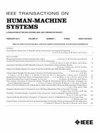情景式解释和数据:传达机器错位的可解释性
IF 3.5
3区 计算机科学
Q2 COMPUTER SCIENCE, ARTIFICIAL INTELLIGENCE
引用次数: 0
摘要
可解释的人工智能必须同时帮助人们理解世界、人工智能,以及人工智能与世界发生错位时的情况。我们提出了情景解释和数据(SID)作为满足这些要求的设计技术。我们训练了两种机器学习算法(一种透明,一种不透明)来预测未来需要紧急响应小组(ERT)出动的病人事件。SID 显示屏将两种算法的输出结果与患者数据和自定义注释结合在一起,以隐含的方式传达透明算法与基础数据的一致性。我们向 30 名护士展示了 SID 显示屏和 10 个实际病例。护士们报告了他们对每位患者的关注程度(1-10)和预期反应(1-4)。在算法预测无 ERT 的所有病例中(无论预测正确与否),护士都能正确区分 ERT 与非 ERT 的关注度和反应。在算法预测有 ERT 的所有病例中,护士都能区分 ERT 和非 ERT 的反应,但不能区分关注。结果还表明,在算法高估和低估未来 ERT 的情况下,护士报告的紧迫性受到了误导性算法指导的不当影响。然而,在 10 个病例中,有 8 个病例护士报告的关注度与预测值相同或更合适,并且在两种预测值发生冲突时,护士对 ERT 和非 ERT 病例的区分能力优于两种算法,甚至优于更准确的不透明算法。因此,SID 似乎是一种很有前途的设计技术,可以减少(但不能消除)不透明和透明算法误导性的负面影响。本文章由计算机程序翻译,如有差异,请以英文原文为准。
Situated Interpretation and Data: Explainability to Convey Machine Misalignment
Explainable AI must simultaneously help people understand the world, the AI, and when the AI is misaligned to the world. We propose
situated interpretation and data
(SID) as a design technique to satisfy these requirements. We trained two machine learning algorithms, one transparent and one opaque, to predict future patient events that would require an emergency response team (ERT) mobilization. An SID display combined the outputs of the two algorithms with patient data and custom annotations to implicitly convey the alignment of the transparent algorithm to the underlying data. SID displays were shown to 30 nurses with 10 actual patient cases. Nurses reported their concern level (1–10) and intended response (1–4) for each patient. For all cases where the algorithms predicted no ERT (correctly or incorrectly), nurses correctly differentiated ERT from non-ERT in both concern and response. For all cases where the algorithms predicted an ERT, nurses differentiated ERT from non-ERT in response, but not concern. Results also suggest that nurses’ reported urgency was unduly influenced by misleading algorithm guidance in cases where the algorithm overpredicted and underpredicted the future ERT. However, nurses reported concern that was as or more appropriate than the predictions in 8 of 10 cases and differentiated ERT from non-ERT cases
better
than
both
algorithms, even the more accurate opaque algorithm, when the two predictions conflicted. Therefore, SID appears a promising design technique to reduce, but not eliminate, the negative impacts of misleading opaque and transparent algorithms.
求助全文
通过发布文献求助,成功后即可免费获取论文全文。
去求助
来源期刊

IEEE Transactions on Human-Machine Systems
COMPUTER SCIENCE, ARTIFICIAL INTELLIGENCE-COMPUTER SCIENCE, CYBERNETICS
CiteScore
7.10
自引率
11.10%
发文量
136
期刊介绍:
The scope of the IEEE Transactions on Human-Machine Systems includes the fields of human machine systems. It covers human systems and human organizational interactions including cognitive ergonomics, system test and evaluation, and human information processing concerns in systems and organizations.
 求助内容:
求助内容: 应助结果提醒方式:
应助结果提醒方式:


